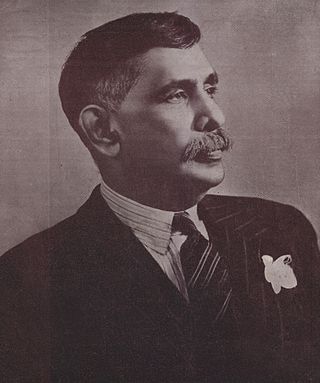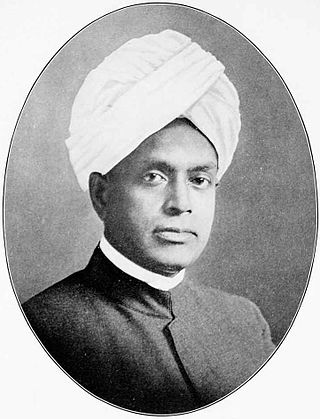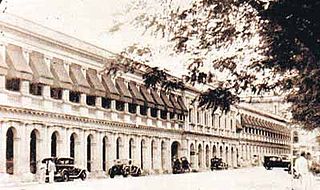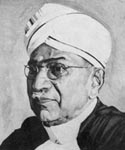| ||
19 seats to the Legislative Council of Ceylon 10 seats were needed for a majority | ||
|---|---|---|
The third election to the Legislative Council of Ceylon was held on 21 April 1921. [1]
| ||
19 seats to the Legislative Council of Ceylon 10 seats were needed for a majority | ||
|---|---|---|
The third election to the Legislative Council of Ceylon was held on 21 April 1921. [1]
In 1833 the Colebrooke-Cameron Commission created the Legislative Council of Ceylon, the first step in representative government in British Ceylon. Initially the Legislative Council consisted of 16 members: the British Governor, the five appointed members of the Executive Council of Ceylon, four other government officials and six appointed unofficial members (three Europeans, one Sinhalese, one Tamil and one Burgher).
In 1889 the number of appointed unofficial members was increased to eight (three Europeans, one Low Country Sinhalese, one Kandyan Sinhalese, one Tamil, one Muslim and one Burgher). [2]
The Legislative Council was reformed in 1910 by the McCallum Reforms. Membership was increased to 21 of which 11 were officially appointed and 10 were unofficial (two elected Europeans, one elected Burgher, one elected educated Ceylonese, two appointed Low Country Sinhalese, two appointed Tamils, one appointed Kandyan Sinhalese and one appointed Muslim). [3] Less than 3,000 Ceylonese were eligible to vote for the four elected unofficial members. [3]
Further reforms were enacted in 1920 by the First Manning Reforms. Membership was increased to 37 of which 14 were officially appointed and 23 were unofficial (11 elected on a territorial basis, five elected Europeans, two elected Burghers, one elected to represent the Chamber of Commerce, two appointed Kandyan Sinhalese, one appointed Muslim and one appointed Indian Tamil. [4]
The following were some of the elected unofficial members, by constituency:

Don Stephen Senanayake was a Ceylonese statesman. He was the first Prime Minister of Ceylon having emerged as the leader of the Sri Lankan independence movement that led to the establishment of self-rule in Ceylon. He is considered as the "Father of the Nation".

Ganapathipillai Gangaser Ponnambalam was a Ceylon Tamil lawyer, politician and cabinet minister. He was the founder and leader of the All Ceylon Tamil Congress (ACTC), the first political party to represent the Ceylon Tamils.

Sir Ponnambalam Ramanathan, was a Ceylon lawyer and politician who served as Solicitor-General of Ceylon.

Sir James Peiris was a prominent leader in the Sri Lankan independence movement, the first elected Vice-President of the Legislative Council of Ceylon and the first native Governor of Ceylon (Acting).

The House of Representatives was the lower chamber of the parliament of Ceylon established in 1947 by the Soulbury Constitution. The House was housed in the old State Council building in Galle Face Green, Colombo and met for the first time on 14 October 1947. The First Republican Constitution of Sri Lanka, adopted on 22 May 1972, replaced the House of Representatives with the unicameral National State Assembly.

Major Edward "Eddie" Alexander Nugawela, ED was a Ceylonese lawyer, soldier and politician. He was the first Cabinet Minister of Education in independent Sri Lanka (1947–1954), later Cabinet Minister of Health (1954–1956), a Member of Parliament and State Council.

The Legislative Council of Ceylon was the legislative body of Ceylon established in 1833, along with the Executive Council of Ceylon, on the recommendations of the Colebrooke-Cameron Commission. It was the first form of representative government in the island. The 1931 Donoughmore Constitution replaced the Legislative Council with the State Council of Ceylon.

Subaiya Natesan was a Ceylonese politician, Member of State Council, Member of Parliament and senator.

Arunachalam Mahadeva, KCMG was a Ceylon Tamil lawyer, politician and diplomat. He served as Minister of Home Affairs (1942-1946) and High Commissioner to India (1948-1949).
A national list member of parliament is a nominated member of parliament who is appointed by a political party or an independent group to the Parliament of Sri Lanka. The number of national list MPs allocated to a contesting party or an independent group depends on the proportion to their share of the national vote. A total of 29 national list MPs are appointed alongside 196 elected MPs making a total of 225 members in the parliament.

The British Ceylon period is the history of Sri Lanka between 1815 and 1948. It follows the fall of the Kandyan Kingdom into the hands of the British Empire. It ended over 2300 years of Sinhalese monarchy rule on the island. The British rule on the island lasted until 1948 when the country regained independence following the Sri Lankan independence movement.

The Mahâ Dissâvas was a Great Officer in the Amātya Mandalaya, or Sinhalese Council of State, in the Sinhalese Kingdoms of monarchical Sri Lanka. Like many of the existing high offices at the time it had combined legislative and judicial powers and functioned primarily equivalent to that of a Provincial governor. The office of Dissava was retained under the successive European colonial powers, namely the Portuguese Empire, the Dutch East India Company and the British Empire. A Dissava was the governor a province known as a Disavanies. With his province, the Dissava held both executive and judicial authority.
The fourth election to the Legislative Council of Ceylon was held in 1924.
Thambaiyah Mudaliyar Sabaratnam was a Ceylon Tamil lawyer, politician and member of the Legislative Council of Ceylon.

Sir Waithilingam Duraiswamy was a Ceylon Tamil lawyer, politician and speaker of the State Council of Ceylon.

George Edmund de Silva was a Ceylonese lawyer and politician. He was the first Cabinet Minister of Industries, Industrial Research and Fisheries in independent Sri Lanka (1947–1948), a Member of Parliament and State Council.
Emmanuel Rasanayagam Tambimuttu was a Ceylon Tamil lawyer, politician and member of the Legislative Council of Ceylon and State Council of Ceylon.
The second election to the Legislative Council of Ceylon was held 20 January 1917.
Sidambarampillai P. Vythilingam was a Ceylonese politician.
Jaganathan Tyagaraja was a Ceylon Tamil barrister, politician and member of the State Council of Ceylon.
{{cite web}}: CS1 maint: unfit URL (link){{cite web}}: CS1 maint: unfit URL (link)